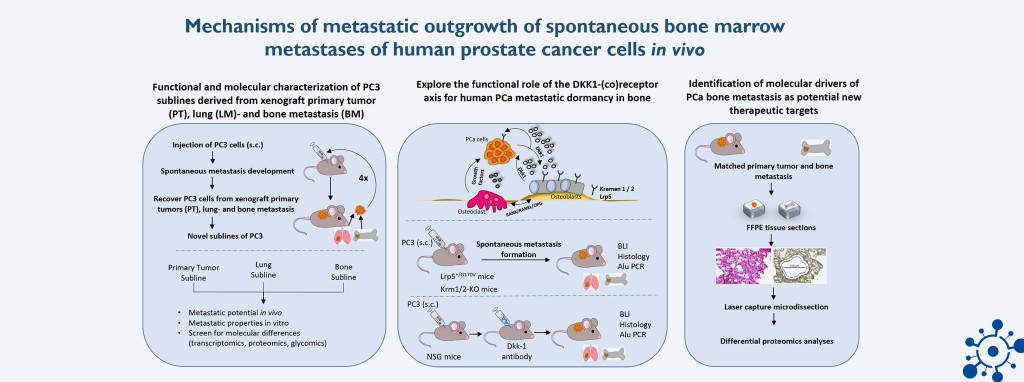P3 - Regulation of tumor cell dormancy in human prostate cancer bone metastasis
Vera Freytag, Marie-Therese Haider & Tobias Lange
Institute of Anatomy and Experimental Morphology, University Medical Center Hamburg-Eppendorf
Microbone
One of the most frequent sites of distant metastasis in prostate cancer (PCa) is the bone marrow. The functional drivers of PCa bone metastasis (BM) formation are not known yet, partly due to a lack of animal models that recapitulate the full metastatic cascade. We optimized a xenograft model representing the multi-step cascade of BM of human PCa. After subcutaneous injection of human PCa cells (PC-3) followed by surgical resection of the primary tumor (PT) these cells spontaneously spread systemically over time, mainly to the lungs and in a small percentage also to the bone. Thus, we have the unique opportunity to study the process of metastasis formation as a whole, including pre-metastatic niche formation by the primary tumor and the outgrowth of single disseminated tumor cells (DTCs) to established metastases. Furthermore, we were able to recover tumor cells from xenograft PTs, lung metastases and BM, re-injected and expanded them multiple times in vivo and ultimately established novel sublines of PC-3 cells. Interestingly, our model essentially results in dormant DTCs in the bone. PC-3 cells are known to secrete high levels of dickkopf-related protein-1 (DKK-1). DKK1 regulates bone remodeling and has already been identified as regulator of metastatic latency in other tumor entities. DKK-1 acts as an inhibitor of the canonical WNT signaling pathway by binding to its main receptor LRP5 or its co-receptors Kremen-1 and -2 (Krm1 and Krm2).
The aim of this project, which is funded in its 2nd period within the framework of the DFG priority program µBONE , is to elucidate the mechanisms of metastatic outgrowth of spontaneous BM of human PCa cells in vivo, with a particular focus on elaborating the interplay between the latency-inducing Wnt antagonist DKK-1 and its receptors on bone cells in this process.
We aim to:
1) Analyze the functional and molecular properties of xenograft PT-, lung metastasis- and BM-derived sublines of PC-3 in detail including divergent metastatic potential in vivo, metastatic properties of the cell lines in vitro and molecular differences (transcriptomics, proteomics, glycomics).
2) Explore and translate our findings regarding the functional role of the DKK1-(co)receptor axis for human PCa metastatic dormancy in bone by performing spontaneous BM xenograft experiments in Krm1-/- , Krm2-/- and Krm1/2-/- KO mice as well as Lrp5+/G170V vs. WT-NSG mice. After analyzing the role of DKK1 receptors, we will investigate the effects of targeting DKK1 itself in a translational approach by applying a clinical phase 1-2 humanized monoclonal antibody against DKK1 (collaboration with Leap Therapeutics, Inc.). Additionally co-culture experiments of PC-3 cells and osteoblasts / osteoclasts (obl/ocl) isolated from Krm1/2 will be performed to assess differentiated obl/ ocl counts, mRNA expression levels of obl and/ or ocl differentiation genes as well as obl and/ or ocl activity assays.
3) Identify further molecular drivers of PCa BM formation as potential new therapeutic targets using xenograft PTs and matched spontaneous BM by conducting laser capture microdissection followed by differential proteomics analyses.
Grants: DFG Priority Program µBONE, 2018-22, 2022-25
Contact: to.lange@uke.de
-
Selected publications on topic
Efficacy of zoledronic acid for the elimination of disseminated tumor cells in a clinically relevant, spontaneously metastatic prostate cancer xenograft model. Böckelmann LC, Freytag V, Ahlers AK, Maar H, Gosau T, Baranowsky A, Schmitz R, Pantel K, Schumacher U, Haider MT, Lange T.Bone. 2023 Jun;171:116741. doi: 10.1016/j.bone.2023.116741. Epub 2023 Mar 18.PMID: 36934984
Xenograft-derived mRNA/miR and protein interaction networks of systemic dissemination in human prostate cancer. Lange T, Samatov TR, Galatenko VV, Steffen P, von Kriegstein H, Spethmann T, Wicklein D, Maar H, Kupfernagel K, Labitzky V, Hanika S, Starzonek S, Ahlers AK, Riecken K, Simon R, Polonski A, Sauter G, Schlomm T, Huland H, Johnsen SA, Schlüter H, Tonevitsky AG, Schumacher U.Eur J Cancer. 2020 Sep;137:93-107. doi: 10.1016/j.ejca.2020.06.025. Epub 2020 Aug 1.PMID: 32750503
Human prostate cancer in a clinically relevant xenograft mouse model: identification of β(1,6)-branched oligosaccharides as a marker of tumor progression. Lange T, Ullrich S, Müller I, Nentwich MF, Stübke K, Feldhaus S, Knies C, Hellwinkel OJ, Vessella RL, Abramjuk C, Anders M, Schröder-Schwarz J, Schlomm T, Huland H, Sauter G, Schumacher U.Clin Cancer Res. 2012 Mar 1;18(5):1364-73. doi: 10.1158/1078-0432.CCR-11-2900. Epub 2012 Jan 18.PMID: 22261809



